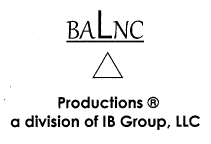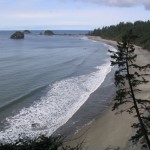Olympic National Park occupies most of the Olympic Peninsula in the Northwest corner of Washington State. U.S. Highway 101 rings the Park and is the key to accessing it. To the South, Interstate 5 intersects US101 in Olympia. Arriving from the East or coming from Sea-Tac Airport, a variety of routes offer easy access to US101, whether traveling by land or on a Washington State Ferry. Arriving from Victoria, B.C. the Blackball Ferry, M.V. Coho docks in Port Angeles, the “Gateway to the Olympics.” Every route offers the opportunity to experience unique scenic and/or cultural opportunities along the way. See below for directions from specific locations.
FROM POINTS NEAR
From US Highway 101, turn south on Race Street and drive about a mile to the Olympic National Park Visitor Center, on the right side of the road.
FROM POINTS FARTHER AFIELD
From wherever you begin the journey to Olympic National Park (ONP), there are several logical starting points. Even this assumption doesn’t cover all the possible routes, but the information provided on this page should be sufficient to help you arrive at the Park as desired. The headings below are organized by initial arrival location: at an airport, by interstate from outside Western Washington, by cruise ship and by rail. Options, advantages and difficulties are identified. Let’s get started.
Seattle-Tacoma (Sea-Tac) International Airport
If the flight is domestic, Baggage Claim is on the lower concourse. There are 14 baggage carousels with reader boards identifying service for incoming flights. Be patient, sometimes the disembarking process is faster than the update of the reader boards and the delivery of the bags.
At Sea-Tac, all of the car rental desks are along the wall opposite the carousels. Please read Rental Car Options below before deciding to rent a car at the airport. Driving from there to the Park presents two Ferry Options or four Overland Routes, each described below.
RENTAL CAR OPTIONS
Visitors arriving at Sea-Tac airport, often not recognizing that an alternative exists, rent a car and drive to Port Angeles, the gateway to Olympic National Park. But the additional expense of this is not necessary to reach Port Angeles or the Park. Twice a day The Dungeness Line, a bus operated by Dungeness Line, leaves from just outside the Baggage Claim area at Sea-Tac airport, and heads directly to Port Angeles. There are several reasons to choose this option—foremost among them is that it can save about 30% of the cost of vehicle travel from the airport to the Park. Taking the bus eliminates the need to drive in an unfamiliar and congested urban setting, and allows passengers to sit back and enjoy the view. Water and a snack are provided by a courteous, professional and informed driver. Additionally, the fee for boarding the ferry is covered in the bus fare and the bus gets priority boarding on the ferry, so there are no worrisome extended wait times on the dock.
Visitors literally walk from Sea-Tac Baggage Claim to the bus. This easy and economical option requires reservations for both the bus and the car rental in Port Angeles, but it’s a smart money-saving alternative.
FERRY OPTIONS
There are two possible ferry routes from the I-5 corridor between Sea-Tac and Edmonds, which is 17 miles north of Seattle. One leaves from downtown Seattle and the other from Edmonds. Both options take about 3.5 hours from departure at the ferry dock to arrival in Port Angeles (this includes a possible wait at the ferry dock of about 30 minutes). The two options are described below the following list of advantages and disadvantages of both routes:
Advantages
- A ferry cruise on Puget Sound.
- A scenic drive.
- A crossing of the Hood Canal Bridge, the world’s first floating bridge on tidal waters.
- Possible side trips to Port Gamble, a National Historic Site and one of the last company-towns in the nation; Port Townsend, the only Victorian Era Waterfront in Puget Sound (a National Historic District); and Sequim, the “Lavender Capital” of the northwest and home to the Dungeness National Wildlife Refuge.
[Sidebar: Engineers initially claimed the Hood Canal Bridge couldn’t be built, and contractors would not even bid on it because of their perceived likelihood of failure. It’s been securely afloat since 1961.]
Disadvantages
- The Hood Canal Bridge transects a navigable waterway, and as such, must open from time to time (an unannounced delay of up to 40 minutes) for large vessels, including the Nuclear Ballistic Submarines stationed at Bangor Naval Base on the canal.
- The cost of the ferry.
- Potentially long waits (several hours in the summer) at the ferry dock.
Ferry Option #1: Seattle to Bainbridge
This route includes taking the Seattle to Bainbridge Island ferry which leaves from downtown Seattle, and then driving State Route (SR) 305 north to SR 3 north, taking SR104 west to US101north into Port Angeles and the Park.
An additional disadvantage of this option is that the ferry terminal is on Seattle’s waterfront, which is under major construction. Driving on the waterfront was never easy, and currently even the locals avoid it.
Ferry Option #2: Edmonds to Kingston
This route includes taking the Edmonds to Kingston ferry, and then driving on State Route (SR) 104 west to US101 north to Port Angles and the Park.
For ferry information, visit:
OVERLAND ROUTES
Overland Route #1
I-5 south to Tacoma, north on SR16, north on SR3, west on SR104 and north on US101 to Port Angeles and ONP. Non-stop time, 3 hours, but more when traffic is heavy, which it is most of the time.
Advantages
- Freedom to travel independent of the ferry system.
- Crossing both the Tacoma Narrows bridge and the Hood Canal Bridge.
- Side trips to Port Gamble a National Historic Site, one of the last company-towns in the nation and Port Townsend, containing a National Historic District because it’s the only Victorian Era Waterfront in Puget Sound. and Sequim the” Lavender Capitol” of the northwest and home to the Dungeness National Wildlife Refuge.
Disadvantages
- Potentially heavy traffic on I-5 and SR16.
- Bridge toll on the Tacoma Narrows Bridge.
- Possible Hood Canal bridge closures.
Overland Route #2
I-5 south to Tacoma, north on SR16, north on SR3, west on SR 302, north on SR3, west on SR106, north on US101 to Port Angeles and ONP. Non-stop time, 4 hours.
Advantages
- Freedom to travel independent of the ferry system.
- Crossing the Tacoma Narrows bridge.
- The scenic drive on SR106 and US101 from Hoodsport to Brinnon.
- Side trips to Port Gamble a National Historic Site, one of the last company-towns in the nation and Port Townsend, containing a National Historic District because it’s the only Victorian Era Waterfront in Puget Sound. and Sequim the” Lavender Capitol” of the northwest and home to the Dungeness National Wildlife Refuge.
Disadvantages
- Potentially heavy traffic on I-5 and SR16.
- Only about 1.5 hours of the drive are scenic.
- Services are limited after leaving SR16.
Overland Route #3
I-5 south to Tumwater, US101 north to Port Angeles and ONP. Non-stop time, 3.5 hours.
Advantages
- Simple route.
- Scenic drive north on US101 from Hoodsport to Brinnon.
- Side trips to Whitney Gardens in Brinnon; Port Townsend, containing a National Historic District because it’s the only Victorian Era Waterfront in Puget Sound. and Sequim the “Lavender Capitol” of the northwest and home to the Dungeness National Wildlife Refuge.
Disadvantages
- Potentially heavy traffic on I-5, particularly from Joint Base Lewis-McChord, 9 miles south of Tacoma to Tumwater the junction of I-5 and US101.
- Miss most of Puget Sound.
Overland Route #4
I-5 south to Tumwater, US 101 north, SR8 west, US12 west US101 north to Lake Quinault and ONP. Non-stop time, 3 hours.
Advantages
- Take advantage of fair weather and start on the west side of the Park and end in Port Angeles.
- Simple route.
Disadvantages
- Potentially heavy traffic on I-5.
- Miss most of Puget Sound.
Portland International Airport
Unless heading from Portland to Seattle with the intention of using either of the ferry routes, the routes from Portland are land routes and start with travel on I-205 to I-5 north to Tumwater, where Overland routes #3 and #4 depart from I-5. Non-stop time for both routes is about 4-4.5 hours. The other options are to drive I-5 further north to Tacoma, where Overland routes #1 and #2 depart I-5. Non-stop time for both routes is about 4.5 hours.
Another land route is to take I-205 south to I-84 west to I-5 south to I405 north to US26 west, Sunset Highway, to Cannon Beach and Seaside Oregon, and then to follow US101 north to Lake Quinault and ONP. Non-stop time is over 5 hours.
Advantages
- Possible stopovers on both the Oregon and Washington coast.
- A number of scenic driving portions on this route.
Disadvantages
- The length of this route.
- Negotiating multiple freeway interchanges to get out of the greater Portland area.
Vancouver, BC (Canada) International Airport
All of the Overland routes listed for Sea-Tac above apply to Vancouver, just add about 2.5 hours to the non-stop time, the travel time between the two airports. There are three additional possible routes, one overland, one by sea and one via Amtrak (rail).
By Rail
The rail trip takes about 4 hours and leaves Vancouver from the Pacific Central Station.
Advantages
- A pleasant and often scenic train ride.
- No delays at the US Border Crossing.
Disadvantages
- Bus service is sometimes substituted in the winter months.
- Trains only run a few times each day.
- The border crossing requires proof of citizenship from the US Department of Homeland Security.
Overland Option
Take BC route 99 south to the Peace Arch Border crossing, and then I-5 south to SR20 west to the Keystone-Port Townsend ferry. After disembarking from the ferry, continue on SR20 west to US101 north to Port Angeles and ONP. Non-stop time 4 hours, including ferry and 30 minutes of wait time at the ferry dock.
Advantages
- Viewing Deception Pass between Fidalgo and Whidbey Islands.
- Ferry ride across Admiralty Inlet with views of the Olympic Mountains.
- Possible stopover in Port Townsend with its National Historic District.
Disadvantages
- Rental cars in Canada may be brought into the US but must be returned to Canada.
- Requires proof of citizenship.
- Reservations are recommended for this ferry.
By Sea
The BC Ferries Connector bus runs from the Vancouver airport to the harbor in Victoria BC. Travel time is about 6.5 hours, plus a 1.5 hour Ferry ride on the Black Ball Ferry to Port Angeles (arrives just steps away from Budget car Rental office). Non-stop time varies.
Advantages
- The ease of getting from the airport to the Park.
- A beautiful BC ferry ride through the gorgeous scenery of the Canadian Gulf Islands.
- A possible stopover in Victoria BC, home of the famous Butchart Gardens.
Disadvantages
- Coordinating schedules can be difficult.
- Completing the trip in one day can be tiring.
Cruise ships
A number of cruise lines begin and end their Alaskan Cruises in either in Vancouver BC or Seattle. In both cases the routes and options described for these cities apply, with one distinction. In Vancouver, the BC Ferries Connector services the Vancouver Cruise ship terminal to and from Victoria, making it possible to travel direct from the ship to Victoria.



